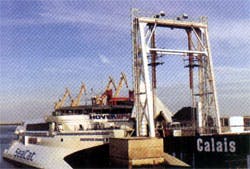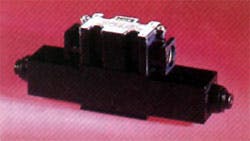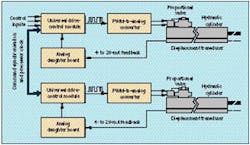Marine cargo-handling specialists Mac- Gregor-Navire joined with Parker Hannifin’s Fluidpower Group to develop the innovative link span, a car-loading system installed at the Port of Calais to handle tourist traffic from Hoverspeed’s new high-speed, cross-Channel SeaCat catamaran service from Dover. A servo-control approach synchronizes travel of two hydraulic cylinders that position a loading ramp between pier and SeaCat. The link span must accommodate a wide range of tidal conditions and loading requirements.
The large-bore hydraulic cylinders are mounted vertically from a gantry that straddles the 131-ton loading ramp — which measures about 7 by 54 m. The cylinder rods are attached to the sides of the ramp, 10 m in from the seaward end. The other end of the ramp simply rests on the pier. The hydraulic cylinders have an 8-m stroke, enabling the seaward end of the ramp to be raised or lowered through 9.6 m. The operator sits at a control station on the gantry and communicates electrically with the electrohydraulic system located in an adjacent building.
Parker Hannifin designed the hydraulic control system around solenoid-operated, highresponse Series D*F proportional valves. The servo electronics was based on a control module produced by Digiplan, another member of the Parker group that specializes in motion-control technology. This processor-based universal drivecontrol module (UDCM) is part of Digiplan’s System 7 range of motioncontrol products, designed to operate all types of modern servo motors, including hydraulic positioners. The UDCM is programmed via a built-in RS232C serial port using Digiplan’s extended version of Standard Communication Protocol motion-control language, which offers over 140 high-level commands for application flexibility. The module also has a powerful servo self-tuning algorithm that automatically evaluates the dynamic performance of the entire system and calculates the most appropriate values for all critical parameters. The self-tuning process — with the ability to fine-tune the system on-site using a portable PC — was a significant factor in completing the project in the 20 weeks from order placement to SeaCat’s inaugural run.
Each arm of the link span forms a complete closed-loop servo in its own right, with manually issued commands — such as up, down and stop — being fed directly from the control station to one of two UDCMs. In this case, however, the modules are synchronized via a high-speed data bus that enables the commands to be executed simultaneously on each axis. The bus also carries the processor clock from one module to the other. This method of preserving a very tight inter-axis timing regime, in conjunction with the modules’ 500-ms servo-loop update rate, ensures that both arms of the link span are driven at exactly the same rate in order to prevent any horizontal skew of the ramp. Furthermore, it means that the system is failsafe. A major failure, such as a hydraulic pipe rupture on either axis, would immediately result in a following error between the commanded position and the absolute position for that axis, causing the system to automatically shut down — with the ramp still maintaining its horizontal stability.\
To prevent any control problem from electrical noise, the UDCMs have optically isolated inputs and outputs, and use digital data communications. The pulse-width-modulated (PWM) velocity demand signal from each module is subsequently converted to a 610-V analog signal prior to being fed to the differential control inputs to the appropriate proportional valve on one of the cylinders. The digital PWM link between the control module and the valve is common to all Digiplan System 7 products, and provides a valuable safety feature by arranging for the duty cycle of the pulse train to only vary from 5% to 95%. Disappearance of the signal — indicating a UDCM fault — is detected immediately, and the system then automatically shuts down.
Conventional closed-loop hydraulic systems use transducers mounted inside the cylinders to provide position feedback. In the case of the link span, the long cylinder stroke makes this approach impractical. Instead, special long-throw transducers were developed and installed in telescoping cylinders external to the power cylinders. Each produces a 4- to 20-mA output signal, which is fed via a current-tovoltage translator stage to produce a 0- to 10-V signal for the analog daughter board on the control unit.
Overall performance of the servos is impressive — the link span has a positional accuracy of 0.8%. The system operates from a 24-V DC supply, allowing auxiliary power to be used in an emergency. With the synchronized closed-loop control, if one of the two main hydraulic pumps stops, the link span can still operate at half speed.
Colin Ford, product support manager, Parker Hannifin, Digiplan Div., Dorset, England, described this application.




